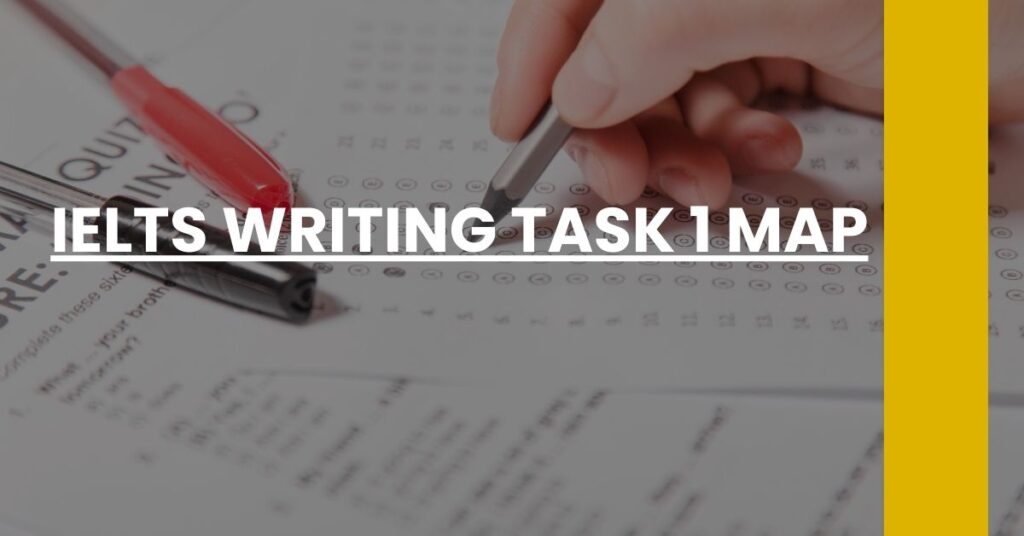Master the skills for IELTS Writing Task 1 map questions with targeted strategies.
- Mapping Your Success: Effective techniques to decode and describe map illustrations.
- Language of Location: Master specialized vocabulary essential for map-related responses.
- Structural Strategies: Learn the layout for high-scoring map descriptions.
Elevate your IELTS Writing Task 1 map responses.
- Understanding IELTS Writing Task 1: Map Questions
- Types of IELTS Map Questions
- The Structure of a Map Response
- Decoding the Question Prompt
- Identifying Key Features in Maps
- Crafting an Effective Introduction
- Writing a Coherent Overview
- Describing Specific Changes
- Describing General Trends
- Using Accurate Map Vocabulary
- Sample Map Response Analysis
- Common Mistakes to Avoid
- Practice Techniques and Resources
- Conclusion: The Path to IELTS Writing Success
Understanding IELTS Writing Task 1: Map Questions
When you encounter IELTS Writing Task 1 map questions, you’re faced with the unique challenge of describing visual changes over time or differences between two geographical layouts. Consider this task as your opportunity to demonstrate the skillful use of language and your ability to capture the essence of a landscape’s evolution or the attributes of a single moment in time.
Test-takers are assessed on their proficiency to succinctly communicate the key features of the map, the accuracy of their language, and their fluency in conveying complex information clearly and coherently. Mastery in these areas doesn’t just reflect your language skills—it projects your ability to navigate and synthesize diverse forms of data, a treasured skill in many areas of life and career.
What Are Examiners Looking For?
Examiners hunt for several competencies in your map response:
- Clarity: how well you can paint a picture for someone who has never seen the map.
- Accuracy: the use of precise vocabulary and appropriate tenses to describe changes or static features.
- Organization: a logical flow that guides the reader through your description without confusion.
Your task is to become an expert at blending these elements seamlessly into your writing. To aid your understanding, numerous resources are available to refine your comprehension and approach to map questions.
Types of IELTS Map Questions
Different scenarios could be presented to you in an IELTS Writing Task 1 map question. You might face a static map that captures a single point in time, requiring you to describe the existing features without reference to change. Such tasks hinge on your ability to discern and communicate the most significant details of the landscape.
Alternatively, progression maps might appear on your test, comparing two different time periods. Here, the spotlight is on your dexterity with tenses: past and present, sometimes even future. Capturing change with the right verb tense is critical in these scenarios. You must discern whether to speak of changes that have already occurred, that are in the process of happening, or those planned for the future.
In either case, the following apply:
- Note prominent landmarks and features first: – streets, buildings, rivers.
- Identify minor details next: – trees, paths, shops.
- Spot the changes or differences: – renovations, removal, expansion.
The Structure of a Map Response
A well-structured response is the backbone of success in IELTS Writing Task 1 map questions. A standardized four-paragraph format is recommended to construct your response logically and to maximize clarity. This includes:
- Introduction: Here, you paraphrase the question prompt to set the discussion context.
- Overview: A summary paragraph captures the main trends, changes, or notable features.
- Body Paragraphs: Two detailed paragraphs dive into specific changes or features, often grouped by geography or time period.
Adherence to this format not only keeps your writing organized but also ensures that all key elements of the task are addressed systematically.
Decoding the Question Prompt
To successfully tackle a map question, you must first understand what is being asked. The question prompt holds the key to your response. Start by identifying the type of map(s) provided and the time frames involved. For tasks with two maps:
- Look at what has been added or removed, note development or reduction in size and remember to consider purpose changes in buildings or areas.
Analyze the task word by word, underlining significant elements that direct what your response should focus on. Recognizing these elements allows you to approach the question with the precision and focus needed to score highly.
Identifying Key Features in Maps
Discerning the key features in a map is akin to finding a narrative amidst a maze of information. To do so effectively:
- Outline the perimeter first: Note the boundaries of the areas shown.
- Mark the most observable features: – Buildings, roads, water bodies are often central to the map’s story.
- Spot subtle details: – Vegetation, land use, smaller paths can reveal the character or the change in an area.
The trick is to distill the map down to its most communicative elements and focus on these in your writing.
Crafting an Effective Introduction
Your introduction is the first impression you make on the examiner, so it’s paramount that it’s clear, concise, and reflective of the task. A strong introduction should:
- Paraphrase the question: Use synonyms and restructure the prompt to show your language skills.
- State the map’s timeframe: Whether it’s past, present, or future, establish the setting.
By restating the question in your own words, you demonstrate an immediate grasp of the task at hand. For additional guidance, IELTS resource websites provide insight into how to craft stellar introductory paragraphs.
Writing a Coherent Overview
The overview is the spot where you can showcase an eagle-eyed perception of the map’s critical elements. Here’s how to do it effectively:
- Summarize the main changes: without going into too much detail—reserve that for your body paragraphs.
- Avoid specifics: at this stage, as names and figures dilute the overview’s purpose.
This paragraph should encapsulate the essence of the map’s narrative, preparing the examiner for a deeper exploration in the subsequent paragraphs. Keep it high-level and informative, setting the stage for the finer details that follow.
Describing Specific Changes
When you delve into IELTS Writing Task 1 map tasks, articulating the changes between maps with precision is essential for scoring well. Here’s how you can zero in on specific changes:
- Observe the before-and-after states: Start by noting every single alteration, no matter how small.
- Categorize changes: Group them into categories such as additions, removals, and modifications.
- Use precise language: Be clear about the nature of each change, indicating growth, development, or decline.
For example, if a building has been demolished and replaced by a park, your description should reflect not only the change but also the transformation indicative of the area’s shifting dynamics.
Detailing Physical Modifications
- Building structures: Explain any evident transformations in size, function, or shape.
- Natural features: Describe alterations to water bodies, vegetation coverage, or land use.
Remember that clarity and precision in your descriptions can vividly bring the map’s evolving story to life. Expand your vocabulary so you can describe these specific changes with accuracy.
Describing General Trends
In addition to specific changes, identifying broader trends is central to your map description. General trends tie together individual changes, offering the examiner a clear understanding of the overall development of an area.
Recognizing Patterns and Development
- Identify patterns: Pay attention to whether changes are isolated incidents or part of a larger trend.
- Discuss development: Reflect on how the changes impact the area as a whole, emphasizing urbanization, industrialization, or perhaps regression.
Discussing general trends showcases your ability to synthesize information, a skill that eminent resources highlight as valuable for IELTS candidates to demonstrate.
Using Accurate Map Vocabulary
Your choice of words can make or break your task response. The IELTS Writing Task 1 map section requires a particular set of vocabulary to highlight directions, locations, and transformations effectively.
- Directional terms: Ensure you know how to correctly use north, south, east, west, and their combinations.
- Location phrases: Phrases like ‘adjacent to’, ‘opposite’, and ‘alongside’ will be key in precise detailing.
- Movement vocabulary: Words such as ‘relocated’, ‘expanded’, ‘converted’, and ‘replaced’ are valuable when describing changes or developments.
Never underestimate the power of the right vocabulary to paint a kinetic picture of static images. Hone this crucial part of your linguistic toolkit by exploring language of location and prepositions of place.
Sample Map Response Analysis
To help you understand what makes for a high-scoring response, let’s dissect a sample answer.
A Breakdown of Excellence
- Incorporation of varied structure: The answer showcases a robust introduction, cogent overview, and detailed body paragraphs.
- Effective use of language: Precise vocabulary and a range of grammatical structures illustrate the candidate’s proficiency.
- Clarity of description: Even someone who has not seen the map could visualize the changes described.
This analysis not only illuminates what examiners are looking for but also inspires your own writing strategy.
Common Mistakes to Avoid
Even the best of us can stumble, but being aware of common pitfalls prepares you to navigate around them.
- Mismatched tenses: Stick to the correct tense for each time period – past, present, or future.
- Inaccurate vocabulary: Double-check the meaning of location-specific terms before using them.
- Overwhelming details: Prioritize changes that represent the most significant trends instead of listing every minute alteration.
Shed light on the common blunders by exploring resources that detail such IELTS map task mistakes and learn to avoid them.
Practice Techniques and Resources
Preparing for the map task of IELTS Writing Task 1 involves consistent practice with a blend of strategy and critique.
- Mock exercises: Recreate exam scenarios by practicing with sample map questions.
- Peer review: Exchange responses with a study partner for feedback on clarity and detail.
- Online tools: Engage with platforms offering specialized IELTS map tasks practice and expert feedback.
A wealth of supporting practice techniques and resources are available to refine your approach to the map tasks and elevate your confidence.
Conclusion: The Path to IELTS Writing Success
Effectively describing maps in IELTS Writing Task 1 is a skill that reflects your broader linguistic capabilities. By mastering map vocabulary, structuring your responses skillfully, and understanding the subtleties of describing geographic changes, you position yourself well to attain a high score in this challenging section of the IELTS.
Remember, your journey to IELTS writing success is paved with detailed observations, accurate vocabulary, and a strong capacity to communicate complex information. With thoughtful practice and strategic preparation, your IELTS Writing Task 1 map responses will not only convey information but will tell the captivating story of landscapes in transition.
Ace the IELTS Writing Task 1 map questions with our expert guide on strategies, structure, and vocabulary for high scores.

